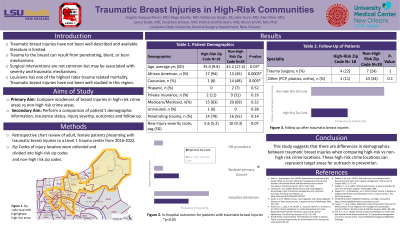Trauma
Category: Quickshot Oral Session 06
Quickshot Oral : Quickshot Oral Session 06
TRAUMATIC BREAST INJURIES IN HIGH-RISK COMMUNITIES
Saturday, February 11, 2023
3:00pm - 4:00pm East Coast USA Time


Angelis Vazquez Perez, MD
resident
Louisiana State University, United States- AS
Alison Smith, MD
United States
Presenter(s)
Principal Contact(s)
Objectives: Traumatic breast injuries are an under-recognized etiology of life-threatening hemorrhage. Long-term consequences include patient’s cosmetic appearance. The impact of these injuries has not been well-studied in underserved areas. The primary outcome of the study was to compare the incidence of these injuries in high-risk crime areas vs non-high risk crime areas. Secondary outcomes included a comparison of patient’s demographic information, insurance status, injury severity, outcomes and follow up.
Methods: A retrospective chart review was performed of adult female patients presenting with traumatic breast injuries to an urban Level 1 trauma center from 2016 to 2022. Location Zip Codes of the injury site were also collected. These were divided into high-risk zip codes and non-high risk zip codes.
Results: A total of 47 patients were included in the study. There was a higher percentage of younger (35 +/- 9.8 vs 45.2 +/- 17.4 years old, p=0.03) and African American patients who suffered traumatic breast injuries in high risk communities (n=17/18, 94% vs. n=13/29, 45%, p=0.0005). The percentage of penetrating trauma was higher in the high risk zip codes (78% vs 55%). Bedside primary closure of the breast injury was more common in the high risk community patients (n=5/18, 28% vs n=3/29, 10%, p=0.04).
Conclusion: Breast trauma is an understudied area of injury, in particular for high risk communities with limited access to healthcare. This study demonstrated differences between high and low risk communities in terms of patient demographics, injury patterns, and primary management. Given the long-term implications for patients with traumatic breast injuries, future studies are needed to better characterize this etiology.
Methods: A retrospective chart review was performed of adult female patients presenting with traumatic breast injuries to an urban Level 1 trauma center from 2016 to 2022. Location Zip Codes of the injury site were also collected. These were divided into high-risk zip codes and non-high risk zip codes.
Results: A total of 47 patients were included in the study. There was a higher percentage of younger (35 +/- 9.8 vs 45.2 +/- 17.4 years old, p=0.03) and African American patients who suffered traumatic breast injuries in high risk communities (n=17/18, 94% vs. n=13/29, 45%, p=0.0005). The percentage of penetrating trauma was higher in the high risk zip codes (78% vs 55%). Bedside primary closure of the breast injury was more common in the high risk community patients (n=5/18, 28% vs n=3/29, 10%, p=0.04).
Conclusion: Breast trauma is an understudied area of injury, in particular for high risk communities with limited access to healthcare. This study demonstrated differences between high and low risk communities in terms of patient demographics, injury patterns, and primary management. Given the long-term implications for patients with traumatic breast injuries, future studies are needed to better characterize this etiology.

